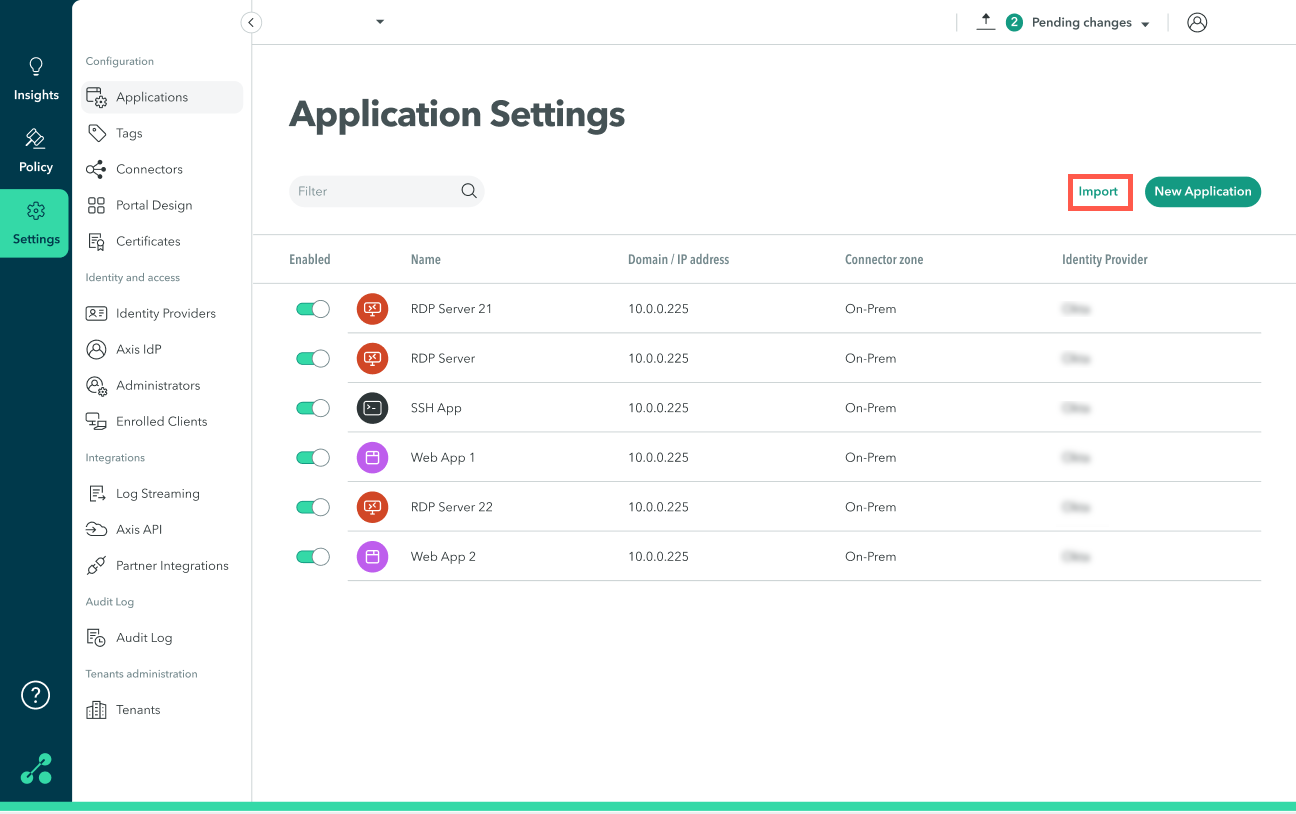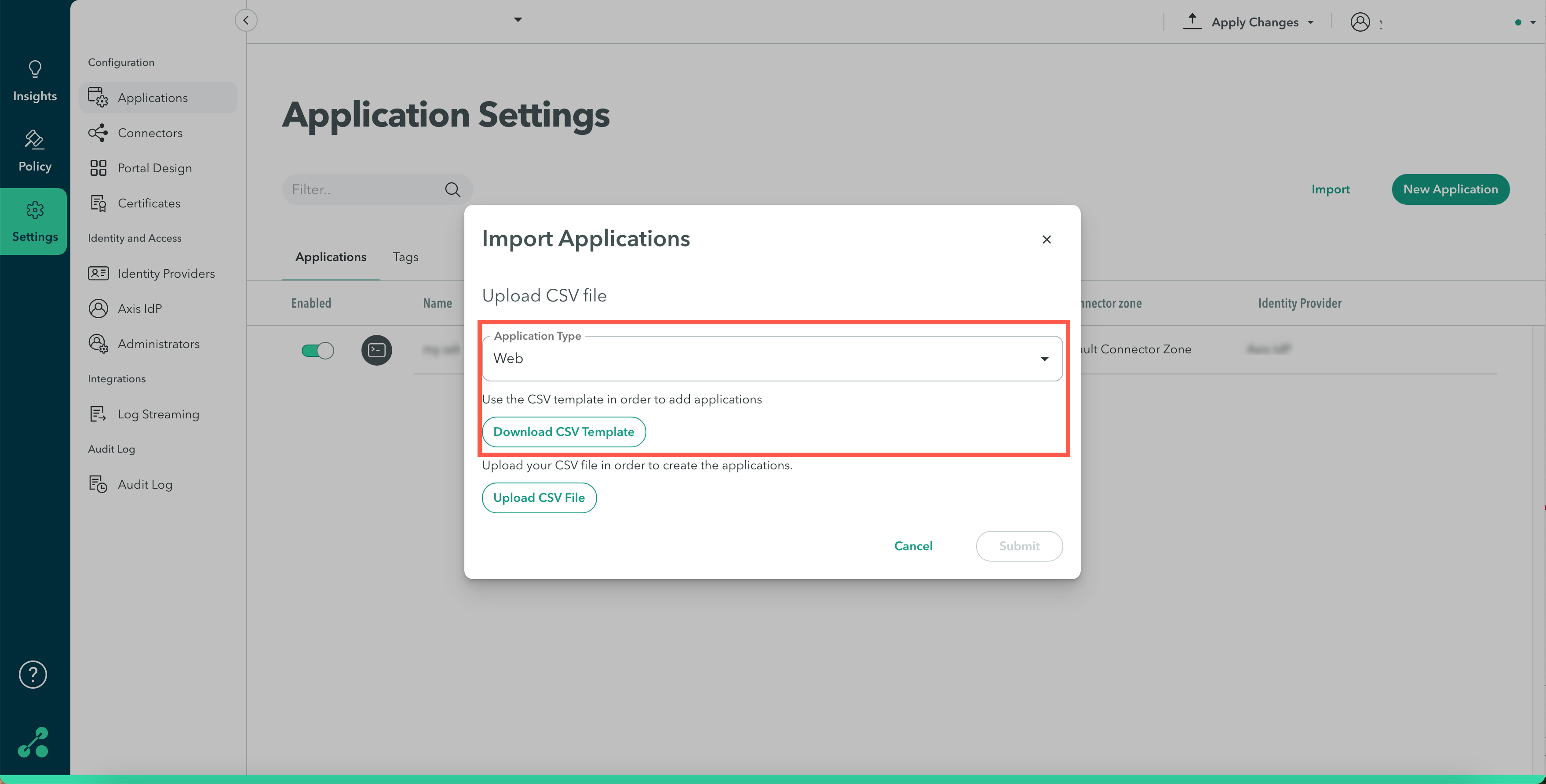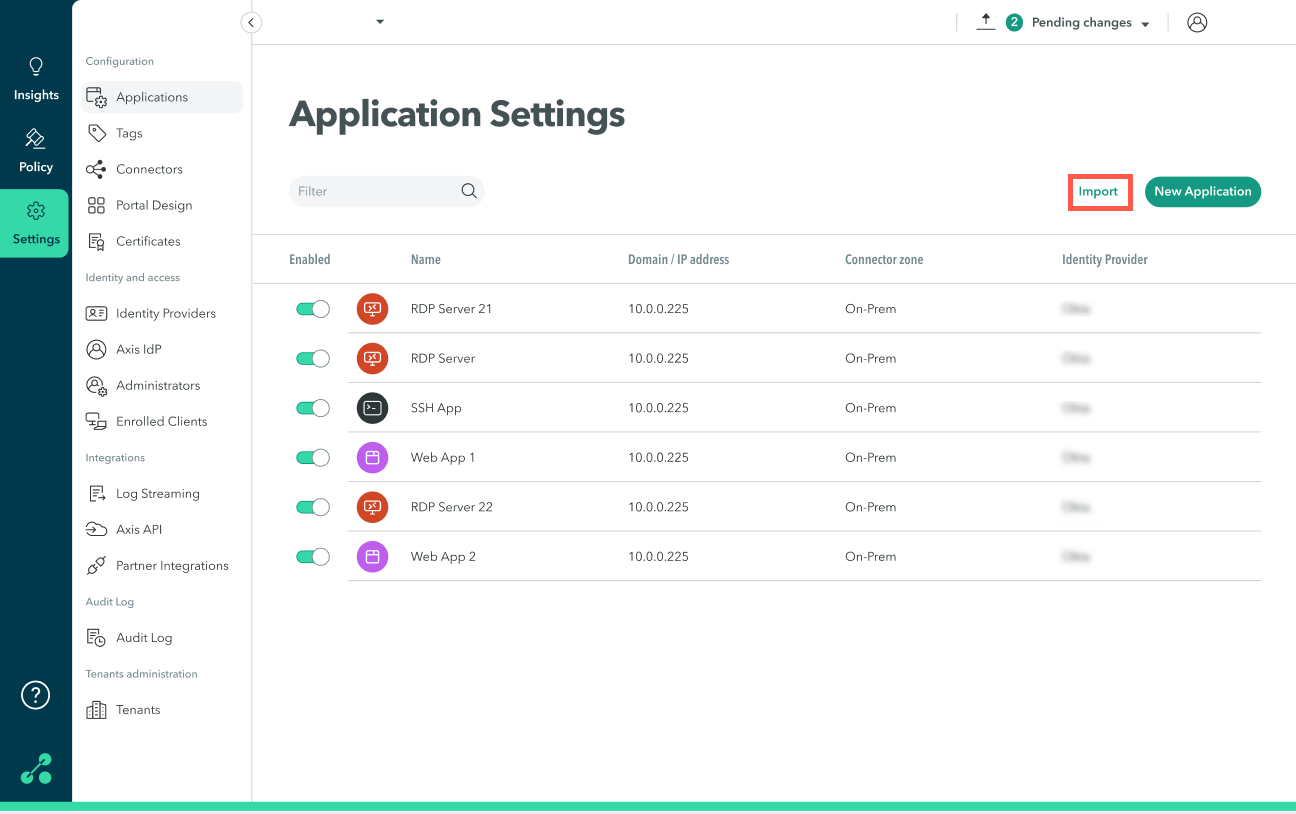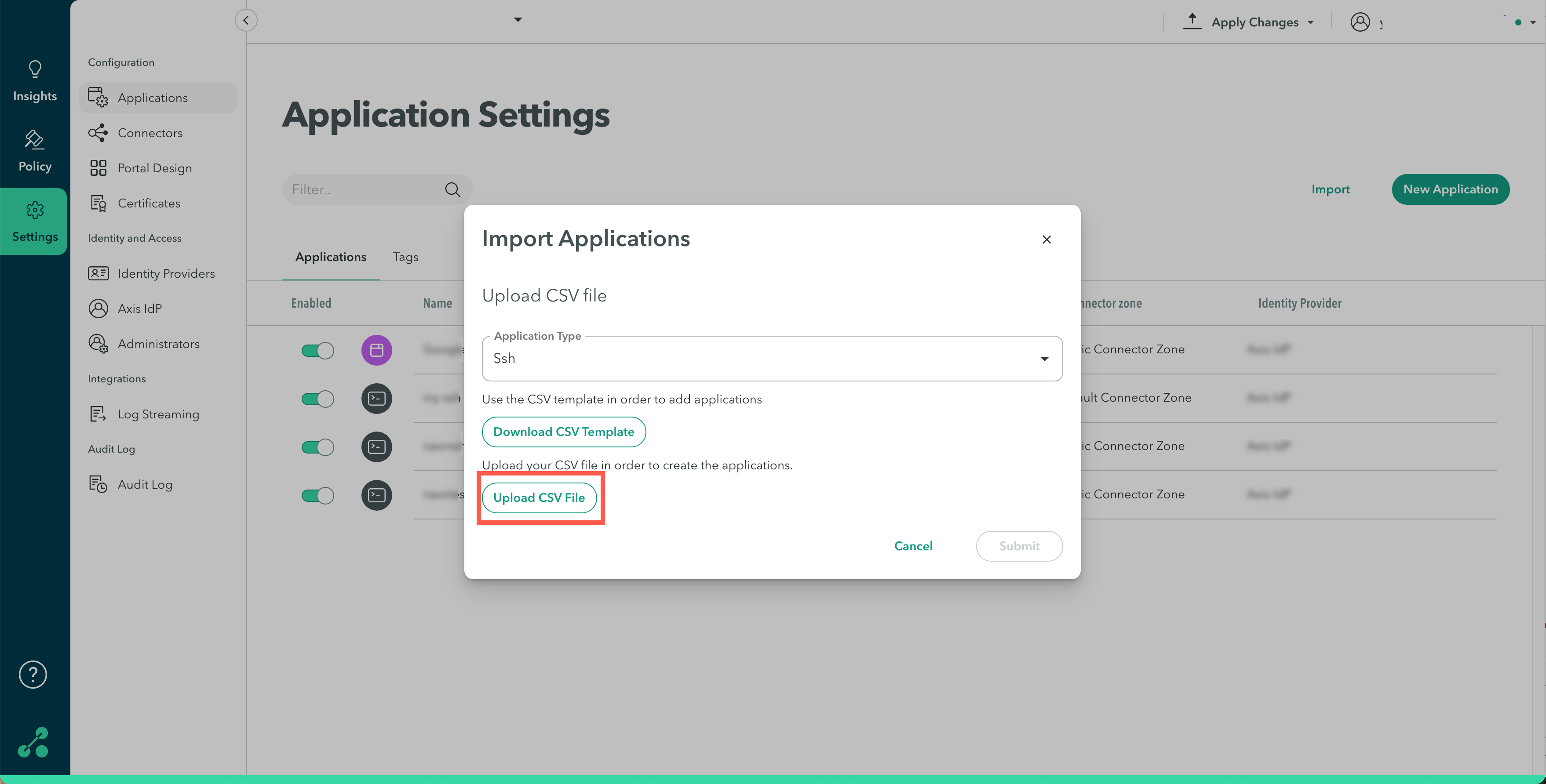Creating Applications in Bulk
To accelerate the onboarding process, applications can be created and imported in bulk using a CSV (comma-separated values) file for the following application types:
- Network Range
- Remote Desktop Server (RDP)
- Self-Hosted Web Application
- SSH Server
Each application type has its own CSV file.
To create and import applications in bulk:
- Download and modify the CSV file for each application type
- Upload the CSV file to Axis Security
Step 1: Downloading and Modifying the CSV File
Download and modify the CSV file for each application type.
To download a CSV file:
- In the Management Console, go to Settings > Applications
- Click Import.

- From the Application Type drop-down menu, select the application type.
- Click Download CSV Template.

Importing Self-Hosted Web Applications
To import self-hosted web applications:
- Select the Web Application Type.
- Click Download CSV Template.
- Open the downloaded CSV file.
- Delete the explanation and example row as shown in the following screenshot.

- Enter the information as shown in the following table.
Note:
Headers marked with an asterisk (*) are required for importing the applications.
| Field | Description | Example |
|---|---|---|
| Name* | Enter a name for the application. | Acme web app |
| Local Address* | Enter the primary domain or an IP. | acme.com |
| Protocol* | Enter a protocol: HTTP or HTTPS | HTTP |
| Port* | Specify the application’s Local Domain/FQDN/IP address that is visible to the connector from the network segment: 80 for HTTP or 443 for HTTPS | 80 |
| Connector Zone* | Enter a connector zone name. | Default connector zone |
| Identity Provider* | Enter an Identity provider name. | Axis IdP |
| Tags (optional) | Enter tags separated by a semicolon ";" | Tag1;Tag2 |
Importing SSH Server Applications
To import SSH applications:
- Select the SSH Application Type.
- Click Download CSV Template.
- Open the downloaded CSV file.
- Delete the explanation and example row as shown in the following screenshot.

- Enter the information as shown in the following table.
Note:
Headers marked with an asterisk (*) are required for importing the applications.
| Field | Description | Example |
|---|---|---|
| Name* | Enter a name for the application | Acme SSH app |
| Local Address* | Enter the primary domain or an IP | acme.com |
| Port* | Specify the application’s Local Domain/FQDN/IP address that is visible to the connector from the network segment: 22 for SSH. | 22 |
| Server username (optional) | When the server username and password fields are defined, users will not be prompted to enter their personal credentials when accessing the application. Note: if you define a server username, you must define a password as well. | Bjones |
| Server password (optional) | When the server username and password fields are defined, users will not be prompted to enter their personal credentials when accessing the application. Note: if you define a server username, you must define a password as well. | Password1 |
| Connector Zone* | Enter a connector zone name. | Default connector zone |
| Identity Provider* | Enter an Identity provider name. | Axis IdP |
| Tags (optional) | Enter tags separated by a semicolon ";" | Tag1;Tag2 |
Note:
When accessing the application users will be prompted to enter their credentials.
Importing Remote Desktop Server Applications
To import remote desktop server applications:
- Select the RDP Application Type.
- Click Download CSV Template.
- Open the downloaded CSV file.
- Delete the explanation and example row as shown in the following screenshot.

- Enter the information as shown in the following table.
Note:
Headers marked with an asterisk (*) are required for importing the applications
| Field | Description | Example |
|---|---|---|
| Name* | Enter a name for the application. | Acme RDP app |
| Local Address* | Enter the primary domain or an IP. | acme.com |
| Port* | Specify the application’s Local Domain/FQDN/IP address that is visible to the connector from the network segment: 3389 for RDP | 3389 |
| Server type (optional) | Enter one of the following server types: DEFAULT OLD * XRDP | OLD |
| AD Domain (optional) | Enter an Active Directory Domain | mydomain |
| Allow users to save credentials (optional) | Enter "TRUE" to allow the Axis Cloud to remember the users' credentials when they connect to the RDP. | TRUE |
| Connector Zone* | Enter a connector zone name | Default connector zone |
| Identity Provider* | Enter an Identity provider name. | Axis IdP |
| Tags (optional) | Enter tags separated by a semicolon ";" | Tag1;Tag2 |
Note:
When accessing the application, users will be prompted to log in with their personal desktop credentials.
Importing Network Range Applications
To import network range applications:
- Select the Network Range Application Type.
- Click Download CSV Template.
- Open the downloaded CSV file.
- Delete the explanation and example row as shown in the following screenshot.

- Enter the information as shown in the following table.
Note:
Headers marked with an asterisk (*) are required for importing the applications
| Field | Description | Example |
|---|---|---|
| Name* | Enter a name for the application. | Acme Network Range app |
| Address Range* | Enter the address ranges in your local network. You can add a DNS wildcard or IP ranges. | *acme.com; 10.0.0.1/24 |
| ICMP Enabled (optional) | Enter "TRUE" to enable ICMP in the network range. | TRUE |
| Allowed ports and protocols* | Enter port range and protocol (TCP/UDP) as follows: "range:protocol". | 1-10:TCP |
| Connector Zone* | Enter a connector zone name. | Default connector zone |
| Identity Provider* | Enter an Identity provider name | Axis IdP |
| Tags (optional) | Enter tags separated by a semicolon ";" | Tag1;Tag2 |
Step 2: Uploading the CSV file to Axis Security
To upload the CSV file:
- In the Management Console, go to Settings > Applications
- Click Import.

- From the Application Type drop-down menu, select the application type.
- Click Upload CSV File.

- Click Submit.
CSV Validation Errors and Troubleshooting
The following table includes possible errors and how to troubleshoot them.
For additional assistance, contact Axis support: [email protected]
| Application Type | Error Message | Troubleshooting |
|---|---|---|
| General validation errors | Invalid CSV file | 1. Make sure that multiple values in a field are separated, using a semicolon ";" 2. Make sure the header names are correct. |
| File size is too large | The maximum file size is 1 MB. | |
| CSV file is empty | Make sure there is at least one filled row | |
| Missing headers | Make sure all of the headers from the downloaded template are included. | |
| Missing information - Name field can’t be empty | Make sure you have populated the Name field. | |
| An application with the same name () already exists in the system | Remove the new entry | |
| Application appears in the CSV more than once with the same name- First appearance will be used | The new entry will not be imported. Change the new application's name. | |
| Self-Hosted Web Application | Missing information - Local Address field can't be empty | Specify the address (domain or IP). |
| Local Address () is invalid | The value is not a valid hostname or IP address. | |
| Missing information - Port field can't be empty | Make sure to enter a port for the application. The common ports used for web applications are: 80 for HTTP 443 for HTTPS | |
| Port () is not in range- Value must be within the following range: 1- 65535 | Make sure the port is within the range 1- 65535, and is relevant for a web application. The common ports used for web applications are: 80 for HTTP 443 for HTTPS | |
| Port () is invalid- Input must be a number within the following range: 1-65535 | Make sure the value entered in the port column is an integer between 1-65535. The common ports used for web applications are: 80 for HTTP 443 for HTTPS | |
| Missing information - Connector Zone field can't be empty | Make sure to fill out the relevant connector zone name. To view a list of connector zones go to Settings-> Connectors-> Connector Zones. | |
| Connector Zone () does not exist | Make sure to add an existing connector zone. To view a list of connector zones go to Settings-> Connectors-> Connector Zones. | |
| Missing information - Identity Provider column can't be empty | Make sure to add the Identity Provider through which the users will authenticate before accessing the application. To view a list of connector zones go to Settings-> Connectors-> Connector Zones. | |
| Identity Provider () does not exist | Make sure to add an existing Identity Provider. To view a list of connector zones go to Settings-> Connectors-> Connector Zones. | |
| Missing information - Protocol field can't be empty | Make sure to specify a protocol (HTTP or HTTPS). | |
| Invalid protocol- Specify HTTP or HTTPS | Make sure the Protocol field contains either HTTP or HTTPS. | |
| Missing information - Remote Address field can't be empty | Make sure to add a URL to access applications from outside the internal network | |
| Remote Address () is invalid - Invalid domain | Make sure the hostname is a valid domain. Example: www.acme.com | |
| Remote Address () is already in use by another application- () | Specify a remote address that is not already in use in your tenant | |
| Remote Address () is invalid Axis domain | For an Axis domain, make sure the remote address ends with "axisapps.io" | |
| No certificates found to match the domain- Remote domain (x) doesn’t match any of the certificates uploaded to the system | If you are using a custom domain, make sure to upload a domain certificate to your tenant. To view a list of certificates go to Settings-> Certificates. | |
| Remote Address () appears more than once with the same name | Make sure to use a remote address that is not already in use. | |
| Root Path () is invalid | Make sure the value entered is a valid root path. | |
| At least one of the additional domains is invalid | One of the additional domains is not in the format <http/s>://: OR the domain is not a valid hostname | |
| SSH Server Application | Missing information - Local Address field can't be empty | Specify the address (domain or IP) |
| Local Address () is invalid | The value is not a valid hostname or IP address | |
| Missing information - Port field can't be empty | Make sure to enter a port for the application. The common port used for SSH applications is 22. | |
| Port () is not in range- Value must be within the following range: 1- 65535 | Make sure the port is within the range 1- 65535, and is relevant for SSH applications. The common port used for SSH applications is 22 | |
| Port () is invalid- Input must be a number within the following range: 1-65535 | Make sure the value entered in the port column is an integer between 1-65535 and is relevant for your SSH application. The common port used for SSH applications is 22. | |
| Missing information - Connector Zone field can't be empty | Make sure to fill out the relevant connector zone name. To view a list of connector zones go to Settings-> Connectors-> Connector Zones. | |
| Connector Zone () does not exist | Make sure to add an existing connector zone. To view a list of connector zones go to Settings-> Connectors-> Connector Zones. | |
| Missing information - Identity Provider column can't be empty | Make sure to add the Identity Provider through which the users will authenticate before accessing the application. To view a list of Identity Providers for your tenant go to Settings-> Identity Providers | |
| Identity Provider () does not exist | Make sure to add an existing Identity Provider. To view a list of Identity Providers for your tenant go to Settings-> Identity Providers | |
| Remote Desktop Server Application | Missing information - Local Address field can't be empty | Specify the address (domain or IP) |
| Local Address () is invalid | The value is not a valid hostname or IP address | |
| Missing information - Port field can't be empty | Make sure to enter a port for the application. The common port used for RDP applications is 3389. | |
| Port () is not in range- Value must be within the following range: 1- 65535 | Make sure the port is within the range 1- 65535, and is relevant for your RDP application. The common port used for RDP applications is 3389. | |
| Port () is invalid- Input must be a number within the following range: 1-65535 | Make sure the value entered in the port column is an integer between 1-65535 and is relevant for an RDP application. The common port used for RDP applications is 3389. | |
| Missing information - Connector Zone field can't be empty | Make sure to fill out the relevant connector zone name. To view a list of connector zones go to Settings-> Connectors-> Connector Zones. | |
| Connector Zone () does not exist | Make sure to add an existing connector zone. To view a list of connector zones go to Settings-> Connectors-> Connector Zones. | |
| Missing information - Identity Provider column can't be empty | Make sure to add the Identity Provider through which the users will authenticate before accessing the application. To view a list of Identity Providers for your tenant go to Settings-> Identity Providers | |
| Identity Provider () does not exist | Make sure to add an existing Identity Provider. To view a list of Identity Providers for your tenant go to Settings-> Identity Providers | |
| Server type () is invalid | Make sure the value is DEFAULT / OLD / XRDP | |
| AD Domain () is invalid | The specified AD Domain is invalid. Enter a valid AD Domain. | |
| Allow Users Save Credentials input () is invalid- Specify “true” or “false” | Make sure to enter "true" if you want to allow users to save their credentials, or "false" if you do not. | |
| Network Range Application | Missing information - at least one of the fields (IP Ranges or DNS Searches) must be filled | Enter address ranges in your local network. You can add a DNS wildcard or IP ranges. |
| At least one of the IP ranges is invalid | Make sure to enter a valid IP range. Example: 10.0.0.2/24 | |
| At least one of the DNS searches is invalid | Make sure to enter a valid DNS search or wildcard. Example: *acme.com | |
| At least one of the excluded DNS searches is invalid | If you choose to exclude a DNS search, make sure the address is valid. | |
| Enable ICMP () is invalid- Specify “true” or “false” | Enter "true" if you want to enable ICMP, or "false" if you do not. | |
| Missing information - Allowed Ports and Protocols can't be empty | Specify the ports and protocols for accessing this application. | |
| At least one of the Allowed Ports and Protocols is invalid | Make sure the value is “:<tcp/udp>” or “” |
Updated almost 4 years ago
